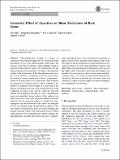| dc.contributor.author | Fathi, Ali | |
| dc.contributor.author | Moradian, Zabihallah | |
| dc.contributor.author | Rivard, Patrice | |
| dc.contributor.author | Ballivy, Gérard | |
| dc.contributor.author | Boyd, Andrew J. | |
| dc.date.accessioned | 2016-09-29T20:44:32Z | |
| dc.date.available | 2016-09-29T20:44:32Z | |
| dc.date.issued | 2015-08 | |
| dc.date.submitted | 2014-10 | |
| dc.identifier.issn | 0723-2632 | |
| dc.identifier.issn | 1434-453X | |
| dc.identifier.uri | http://hdl.handle.net/1721.1/104448 | |
| dc.description.abstract | Three-dimensional tracking of changes of asperities is one of the most important ways to illustrate shear mechanism of rock joints during testing. In this paper, the changes of the role of asperities during different stages of shearing are described by using a new methodology for the characterization of the asperities. The basis of the proposed method is the examination of the three-dimensional roughness of joint surfaces scanned before and after shear testing. By defining a concept named ‘tiny window’, the geometric model of the joint surfaces is reconstructed. Tiny windows are expressed as a function of the x and y coordinates, the height (z coordinate), and the angle of a small area of the surface. Constant normal load (CNL) direct shear tests were conducted on replica joints and, by using the proposed method, the distribution and size of contact and damaged areas were identified. Image analysis of the surfaces was used to verify the results of the proposed method. The results indicated that the proposed method is suitable for determining the size and distribution of the contact and damaged areas at any shearing stage. The geometric properties of the tiny windows in the pre-peak, peak, post-peak softening, and residual shearing stages were investigated based on their angle and height. It was found that tiny windows that face the shear direction, especially the steepest ones, have a primary role in shearing. However, due to degradation of asperities at higher normal stresses and shear displacements, some of the tiny windows that do not initially face the shear direction also come in contact. It was also observed that tiny windows with different heights participate in the shearing process, not just the highest ones. Total contact area of the joint surfaces was considered as summation of just-in-contact areas and damaged areas. The results of the proposed method indicated that considering differences between just-in-contact areas and damaged areas provide useful insights into understanding the shear mechanism of rock joints. | en_US |
| dc.description.sponsorship | Hydro-Québec (FONCER-INFRA Grant) | en_US |
| dc.publisher | Springer Vienna | en_US |
| dc.relation.isversionof | http://dx.doi.org/10.1007/s00603-015-0799-6 | en_US |
| dc.rights | Article is made available in accordance with the publisher's policy and may be subject to US copyright law. Please refer to the publisher's site for terms of use. | en_US |
| dc.source | Springer Vienna | en_US |
| dc.title | Geometric Effect of Asperities on Shear Mechanism of Rock Joints | en_US |
| dc.type | Article | en_US |
| dc.identifier.citation | Fathi, Ali, Zabihallah Moradian, Patrice Rivard, Gérard Ballivy, and Andrew J. Boyd. “Geometric Effect of Asperities on Shear Mechanism of Rock Joints.” Rock Mechanics and Rock Engineering 49, no. 3 (August 1, 2015): 801–820. | en_US |
| dc.contributor.department | Massachusetts Institute of Technology. Department of Civil and Environmental Engineering | en_US |
| dc.contributor.mitauthor | Moradian, Zabihallah | |
| dc.relation.journal | Rock Mechanics and Rock Engineering | en_US |
| dc.eprint.version | Author's final manuscript | en_US |
| dc.type.uri | http://purl.org/eprint/type/JournalArticle | en_US |
| eprint.status | http://purl.org/eprint/status/PeerReviewed | en_US |
| dc.date.updated | 2016-08-18T15:21:24Z | |
| dc.language.rfc3066 | en | |
| dc.rights.holder | Springer-Verlag Wien | |
| dspace.orderedauthors | Fathi, Ali; Moradian, Zabihallah; Rivard, Patrice; Ballivy, Gérard; Boyd, Andrew J. | en_US |
| dspace.embargo.terms | N | en |
| dc.identifier.orcid | https://orcid.org/0000-0002-6431-5787 | |
| mit.license | PUBLISHER_POLICY | en_US |
